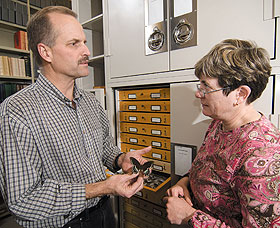  |
| HOME | THIS ISSUE | CALENDAR | GRANTS | BACK ISSUES | < BACK | NEXT > |
Butterfly atlas provides data, details about Connecticut species by Cindy Weiss - April 7, 2008 | ||||||
| With a month to go before trees leaf out, it may seem early to look for butterflies in Connecticut. But on a warm day, you might see Nymphalis antiopa, or Mourning Cloak, spread its yellow-bordered maroon wings in the sun. The Mourning Cloak is often the first butterfly seen each year in the state, according to The Connecticut Butterfly Atlas, a colorful 376-page reference to Connecticut’s 117 known butterfly species. Jane O’Donnell, biology collections manager in the College of Liberal Arts and Sciences, chaired the project and edited the atlas. Co-editors were David Wagner, professor of ecology and evolutionary biology, and Lawrence Gall of Yale University’s Peabody Museum of Natural History. The book, published last summer by the state Department of Environmental Protection (DEP), provides a baseline of information about the distribution of Connecticut’s butterfly population. “A lot of our endangered, threatened, and special concern species are butterflies,” says O’Donnell. The book’s handy size (5 inches by 9 inches), clear descriptions, and colorful accompanying photos of butterflies in all stages of development have made it an identification tool for lepidopterists. “It’s not really a field guide, but people are using it that way,” says O’Donnell.
Gathering information for the atlas took five years, beginning in 1995. Nearly every section of the state was searched for butterflies. The project was a joint venture of the DEP, the Connecticut Entomological Society, and the Connecticut Butterfly Association, and was largely volunteer-based. More than 350 volunteers contributed nearly 8,500 specimens or photos with accompanying data cards. The card showed the location of the find, based on U.S. Geological Survey topographical maps, the abundance of the butterfly, and 16 other information points. All finds had to be verified by a committee of butterfly experts that included Wagner, Gall, the late Charles Remington, curator at the Peabody Museum, and others. Volunteers then entered the verified information into a database. Information that had been gathered before the project was also sought from institutional collections, transcribed, and entered into computer files. The species most commonly found during the project was Phyciodes tharos, or Pearl Crescent, which flies close to the ground in open areas in most parts of the state. These delicate creatures – mottled orange and black with an inch-and-a-half wing span – draw nectar, but also feed at dung and imbibe fluids from carrion, the atlas observes.
The Cabbage White, which you might find on a cabbage, kale, or cauliflower, and the tiny European Skipper (one-inch wingspan) – both non-native species – were also found to be common. The Common Ringlet, an immigrant that only became well established in the state in the ’90s, also thrives here, favoring open, grassy areas. A rarer find is the Northern Pearly Eye, which is most active at dusk and can be found at sap flows and on rotten fruit and dung. Some of the butterflies were more challenging than others to locate. Hessel’s Hairstreak, for example, lives high in the trees of Atlantic white cedar swamps and only comes down to feed in the early morning or late afternoon. In Storrs, the Fenton River near the pumping station is “butterfly heaven” at certain times of the year. A dozen or more species can be found there in an afternoon, O’Donnell says. Collecting is normally not a threat to the butterfly population, she says. The atlas includes guidelines for responsible collecting, and it encourages collectors to record their observations of butterfly behavior and to make photographic records. The atlas is a rich repository of information about each species. Their life histories were contributed by the Agricultural Experiment Station in New Haven. A map shows where they can be found, and a narrative describes the habitat and host plants they favor. The next step for the project would be to create a network of people to monitor the butterfly population by walking a set transect every week and counting the butterflies they see, she says. As Connecticut becomes more suburban and “mall-ized,” butterfly habitats are lost or fragmented and species are at risk. Deer browsing is also a problem, if the deer eat host plants. Gardeners can help by planting native host plants that butterflies like – among them, sedge grasses and wild Indigo – and by realizing that a worm found on a cabbage or broccoli plant is not necessarily a bad thing, O’Donnell says. The prospect of keeping track of butterflies remains daunting, however. “Even though Connecticut is a small state,” she says, “there’s a lot of ground to cover.” |
| ADVANCE HOME UCONN HOME |


